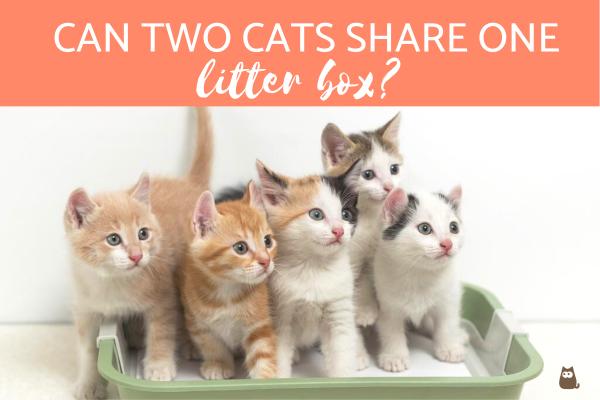Can Two Cats Share One Litter Box?



See files for Cats
Cats are incredible pets. They are funny, independent and very clean. Everyone knows that cats usually do their business inside a litter box. In fact, this factor is one of the main reasons why many people choose to adopt a cat, since they don't need to go out on the street as often as dogs.
Many of us enjoy cats so much that we decide to adopt two. But then we wonder, can two cats share one litter box? Would is be sanitary for them to share one litter box? In this AnimalWised article we will explain why it's not idea to have two cats share one litter box. Keep reading to find out more"
Can two cats share one litter box?
According to experts in feline behavior, it is not advised to provide two cats with only one litterbox. In fact, these experts recommend to have an equal number of litter boxes to that of cats, plus one. In other words, if you have two cats, you should provide them with three litter boxes.
Why? Well, there's two main reasons: behavior and health. On the first hand, cats are territorial animals that need to have their own space for certain things. One of the most personal things felines do is urinate and defecate. In the wild it leaves them vulnerable to predators so they need to be on an alert. In the comfort of their own homes, most domestic cats prefer to have their own litter box with their own smell for their necessities.
Another important reason is health. Having two cats urinate and defecate in the same litter box will lead to a litter box full of bacterias. If you work away from home and don't have time to clean it every time they use the litter box, this is not ideal. The accumulation of their feces can lead to health issues. This is why it's best that they have their own litter box and an extra on just in case.
This way, they both feel safe and comfortable in their own litter box. The litter boxes will also be more clean and therefore help prevent any infections. So, even if your two cats don't mind sharing one litter box, it's best to provide them with 2-3 litter boxes for health reasons.
Cleaning your cat's litter boxes
You should clean your cat's litter boxes at least weekly. However, you must scoop our their droppings daily. Here, we'll include a simple guide to how to clean your cat's litter box:
Daily
- Scoop out their droppings at least once per day.
- Dispose of their droppings.
- Wash the litter scoop with soap and water.
- Put it away in a sealed plastic bag for the next day.
Weekly
- For a weekly deep cleaning, first, empty the litter box entirely.
- Dispose of the litter and the droppings.
- Wash the litter box with soap and water.
- Let it dry or dry it with a clean paper towel.
- Now add new litter to the box.
- Assemble it back together and put it back to its designated area.
Tip: avoid cleaning it with harsh chemicals such as bleach. Cats are very sensitive to smells and this can cause them to completely avoid the litter box. We must also keep in mind that certain chemicals are even toxic to cats. So stick with your common white soap and water to disinfect the litter box.
Types of litter boxes for cats
Lastly, keep in mind that in today's market there are a number of types of litter boxes for cats. Choose the one that feels best for you and your cat.
The litter box will need to be easy to access, located in a calm place in your house or apartment and, it should be away from the kitchen or where your cat eats. Make sure it's the correct size for your cat so they can move freely and not feed pressured inside a small box.
Here are some of the most common litter box designs:
- Common litter box: with no top.
- Litter box with roof: some also include a cat door. This helps the odor stay inside.
- Self-cleaning litter box: these are some of the newer designs for busy pet owners.
Choose the right design for you and your cat and select a comfortable place in your home to put them. Learn more in our article about the different types of cat litter.
If you want to read similar articles to Can Two Cats Share One Litter Box?, we recommend you visit our Basic care category.
- Agustín, A. (2008). Adoption: behavior and well-being. Veterinary dissemination consultation. 16, 153. 31-35.
- Neilson, J. (2004). Thinking outside the box: feline elimination. Journal of Feline Medicine and Surgey . 6, 5-11.





